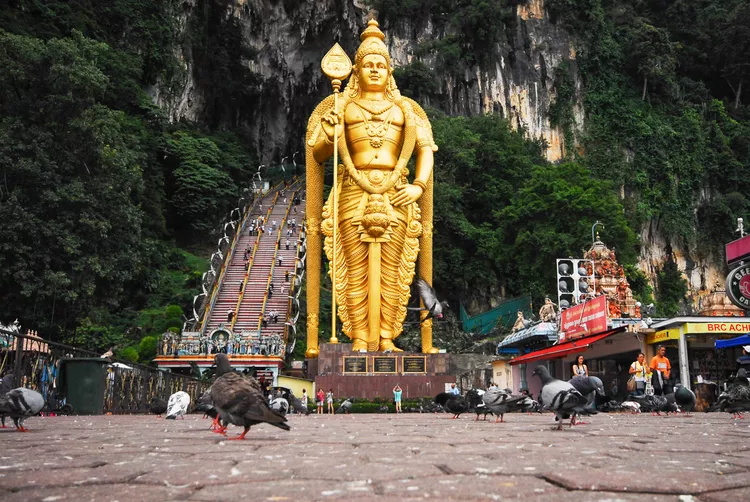Summary
The Batu Caves in Malaysia are one of the most important Hindu religious sites outside of India and are a must-see once you tire of shopping and wandering Kuala Lumpur.
Just eight short miles north of the city, the Batu Caves are an essential destination among the many interesting things to do around Kuala Lumpur. The caves attract roughly 5,000 visitors daily, who come to conquer the challenging 272 steps leading up to the majestic caverns.
These iconic caves serve as a focal point for Hindu Malaysians, particularly during the festival of Thaipusam, as they are home to a 113-year-old temple alongside an impressive display of Hindu artwork and shrines.
Every year, the Batu Caves draw over a million devotees and spectators during the Hindu festival of Thaipusam. An eight-hour procession filled with music and ceremonies features offerings presented to a giant statue of Lord Murugan, the Hindu God of War.
What to Expect at the Batu Caves
As you approach the caves, the first thing that captures your attention is the towering golden statue of Lord Murugan. Erected in 2006, it is the largest in the world dedicated to this deity and stands sentinel over the 272 leg-burning steps that lead to the cave entrances.
As you ascend the steps, you will likely be entertained by a troop of monkeys that thrive on the steady inflow of tourists. While taking pictures may be tempting, it’s essential to keep an eye on your belongings!
Resting points along the stairway offer picturesque views of the suburban landscape of Kuala Lumpur.
:max_bytes(150000):strip_icc():format(webp)/DSC_0849-e6fbab0436f14ab59ba3caf50ecd342e.jpg)
Temple Cave, Dark Cave, and Art Gallery Cave
The jagged limestone hillside of Batu Caves hosts three main caverns.
The largest and most frequented is the Temple Cave, featuring an impressive ceiling soaring over 300 feet high. Within this illuminated cave, various Hindu shrines come alive through ornate depictions of myths and legends.
The entrance below Temple Cave is recognized as the Dark Cave, the wildest of the trio. This 6,500-foot underground stretch is adorned with striking limestone formations and is home to many cave-dwelling species, including the endangered Trapdoor Spider.
Exploring the Dark Cave requires prior booking for a spelunking tour, which necessitates a good level of physical fitness, as some crawling is involved; it’s advisable to bring a change of clothes.
Across an attractive set of bridges lies the Art Gallery Cave, which contains Hindu carvings and vibrant wall paintings detailing the tales of Lord Murugan and other Hindu legends; anticipate a small entry fee.
Rock Climbing at the Batu Caves
Although many visitors come just to see the caves, the surrounding limestone hills and crags offer some of the finest rock climbing opportunities in Southeast Asia.
With approximately 170 bolted routes, climbers are presented with great challenges, catering to levels ranging from 5A to 8A+. For those less inclined towards technical climbing, the area offers numerous opportunities for hiking, scrambling, and bouldering.
:max_bytes(150000):strip_icc():format(webp)/DSC_0773-9f26963d57584d73aff2a27e8fb94226.jpg)
Monkey Safety at the Batu Caves
Visitors should expect both entertainment and occasional harassment from the local Macaque monkeys that inhabit the area. These monkeys prove to be irresistible subjects for photographs, yet they may also resort to stealing from and even biting tourists.
It’s crucial to act quickly if a monkey grabs your belongings – whether it’s a backpack or water bottle, drop it immediately. The monkeys take tug-of-war as a challenge, which could result in a bite before they relinquish their grip!
Getting to the Batu Caves
The Batu Caves are situated in the Gombak district, a northern suburb just eight miles from the bustling center of Kuala Lumpur.
During Thaipusam in late January, there is a notable increase in the availability of buses and other transport options to shuttle individuals to and from the caves.
You can utilize Kuala Lumpur’s transportation system to reach the Batu Caves using the following methods:
Train
- Option 1: Board the KTM Komuter Sentul-Port Klang line (red on transit maps) north to the newly opened Batu Caves Komuter station. Alternatively, Sentul station can be used if there are further construction delays on the line.
- Option 2: Take the monorail north to Chow Kit station and then transfer to bus U6 to the caves. Remember to retain your ticket for the return journey since bus tickets are valid throughout the day.
Bus
Traveling by bus to Batu Caves amidst city traffic can take approximately 45 minutes. For a quicker journey, consider taking a train north and then switching to a bus or taxi for the final leg of the trip.
Alternatively, you can catch bus #11 from the busy Bangkok Bank bus terminal on Jalan H.S. Lee, located near Chinatown, which travels directly to the caves.
Taxi
A taxi ride from the Golden Triangle in Kuala Lumpur generally costs around RM 25. It’s advisable to arrange for your driver to return later or use the train to get back after your visit to the caves.
Some Things to Know Before Visiting the Batu Caves
- Admission to the Batu Caves is free.
- The caves are open year-round from 7:00 AM to 7:00 PM.
- Accessibility can be challenging, so senior visitors may find it difficult to navigate the stairs leading to the entrances.
- Expect muddy conditions in the wild caves; bringing a change of clothes is advisable if you plan on exploring any of the spelunking tours.
- Various stalls and restaurants provide Indian cuisine outside the entrance to Batu Caves, but for better quality food at lower prices, consider returning to Kuala Lumpur.
- To prevent excessive charges, it’s wise to bring your own drinking water.




